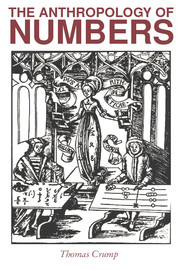Book contents
- Frontmatter
- Contents
- List of illustrations
- Preface
- Acknowledgements
- 1 The ontology of number
- 2 The cognitive foundations of numeracy
- 3 Number and language
- 4 Cosmology and ethnoscience
- 5 Economy, society and politics
- 6 Measurement, comparison and equivalence
- 7 Time
- 8 Money
- 9 Music, poetry and dance
- 10 Games and chance
- 11 Art and architecture
- 12 The ecology of number
- Notes
- References
- Index
- Cambridge Studies in Social and Cultural Anthropology
- Frontmatter
- Contents
- List of illustrations
- Preface
- Acknowledgements
- 1 The ontology of number
- 2 The cognitive foundations of numeracy
- 3 Number and language
- 4 Cosmology and ethnoscience
- 5 Economy, society and politics
- 6 Measurement, comparison and equivalence
- 7 Time
- 8 Money
- 9 Music, poetry and dance
- 10 Games and chance
- 11 Art and architecture
- 12 The ecology of number
- Notes
- References
- Index
- Cambridge Studies in Social and Cultural Anthropology
Summary
The use of numbers in relation to language
The relation between number and language is complex, and any research into this relationship is bound to be full of pitfalls. To begin with it should be recognised that ‘the evolution of a developed understanding of number proceeded through the growth of spoken systems’ (Hurford 1987: 144). Not only is no thought possible without speech, but the conceptualisation of number and numerical processes is only achieved at an advanced stage of cognitive development. In practice a child's linguistic competence is almost completely developed (Fry 1979: 34) before it is capable of mastering numerical systems at even the most elementary level. Such systems do not necessarily exist in every culture, as witness the general absence of any system of numerals in Australian vocabularies (Dixon 1980: 107). But there may still be expedients for conveying numerical information. Two examples illustrate this point: first ‘aboriginal Australians did have ways of measuring and indicating say the number of days until some planned social event, through pointing at different points on the palm of the hand’ (ibid.: 108). Second, the Wedda of Ceylon, described by Menninger (1977: 33) as a ‘primitive tribe with a very low level of culture’, can only count a quantity of any objects by pairing them one by one with some other objects (Scriba 1973: 400).
- Type
- Chapter
- Information
- The Anthropology of Numbers , pp. 31 - 46Publisher: Cambridge University PressPrint publication year: 1990



